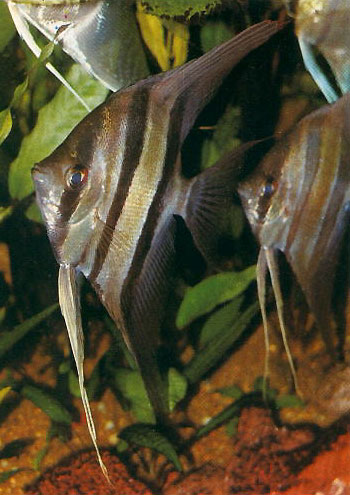
Pterophyllum Altum
|
| Pterophyllum Altum |
The two fishes shown in these two photos are two
different kinds of wild angelfishes. The fish to the right is a
wild-caught altum while the fish below left is what was once
called the eimekei. I was able to keep my eye on the "eimekei
because of the shining scale immediately before his first dorsal
spine. The altum is recognized easily by the deep brown or gray
vertical stripes and the clear soft rays of his unpaired fins.
The "eimekei," on the other hand, is easily identified by the
light markings in the unpaired fins.
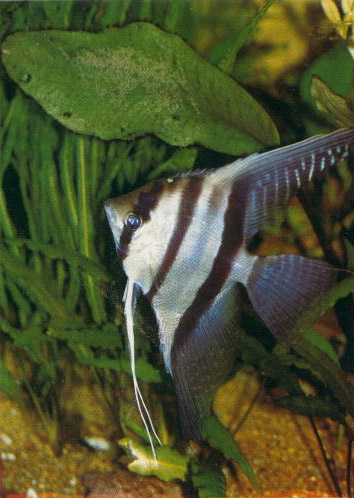
Pterophyllum Eimekei
|
| Pterophyllum Eimekei |
It was a bit sad leaving Japan behind. Having lived there for
a while (1950-52 as a lieutenant in the Medics) I had a liking
for the place. My wife, Evelyn, studied Japanese too. It was
hard to leave with a happy heart, but I did promise to come back
in a few weeks to attend the world's largest koi show. I also
wasn't too happy about the long 12 hour flight from Tokyo to
Sydney, Australia.
But the time flew by as I worked on the text for my book, Koi
Varieties and it wasn't too long before the long night flight
was over and the crystal-clear waters of the ocean were visible.
We made an intermediate stop in Queensland. It meant a few extra
hours before we were in Sydney, but we needed to stretch out
legs.
As we left our Quantas airplane, we were surrounded by
smiling plainclothes policemen, each of whom had a Labrador
Retriever. We were asked politely to line up with our personal
possessions on the floor in front of us. Then the dogs were
paraded down the line. I guess a sample of some drug was planted
along the line, for a dog dove into the middle of the pile and
came out with what looked like a stuffed men's sock. The
policeman could not remove it from the dog's mouth so they
brought in another dog! Thankfully, the second dog wasn't as
lucky as the first and we were ushered into the Transit Lounge
where I was able to buy and smoke a lovely Havana Montecristo #2
cigar.
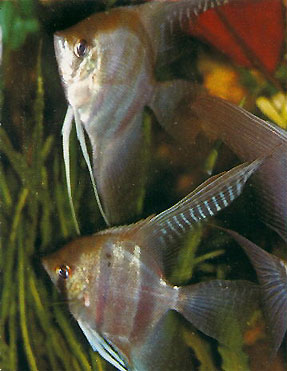
Pterophyllum Eimekei
|
| Pterophyllum Eimekei |
That sort of made up for the dog show, and in a few hours we
landed in Sydney airport. Right photo shows two "eimekei" which
may have been the spawning pair previously. The weather was
beautiful (January is Australian summer) and I could hardly wait
to get to our hotel on the beach outside Sydney. The hotel was
right on the beach and as I gazed from the balcony of my 6th
floor suite I could hardly believe my eyes. I couldn't tell the
boys from the girls watching them from behind. The boys' hair
was as long as the girls' and the girls' bathing suits were as
brief as the boys'...one piece, topless. A stern look from
Evelyn and I was convinced i should have a nap after flying and
working all night! Could you believe that it started raining
that night and no one was on the beach for the next 5 days! I
left Sydney for Auckland, New Zealand with hopes that someday
soon I can make it back to Sydney to see if the long hair style
the boys were wearing is still in vogue!
It was early the next morning when Karl Schnell, the managing
director of T.F.H. (Australia) turned up for breakfast...very
apologetic about the weather. Off we went to his office to talk
a little business: new books, a larger TFH magazine, and what
was happening to the U.S. dollar against the Australian dollar.
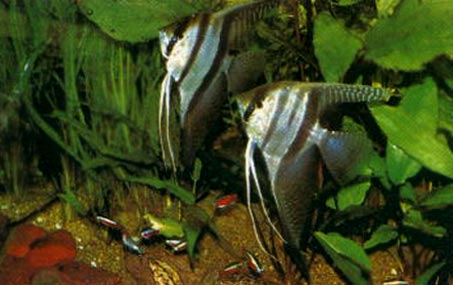
Pterophyllum Eimekei
|
| Pterophyllum Eimekei |
As I was sitting by his desk next to a fairly large
aquarium...perhaps 100 gallons in capacity...I commented that
two of his wild Pterophyllum scalare seemed to be getting ready
to spawn. The female already had her ovipositor extending from
her anal pore in what looked like a large, white dot, while the
male was busy scrubbing off a large leaf, at the same time as he
chased away the other Pterophyllum. Karl mentioned that they
spawn regularly.
Wild angelfish, the kind 10-12 inches (25-30 cm) high, have
never been spawned before...at least not that I know of anyway.
Dr. Eduard Schmidt-Focke, of discus fame, was able to cross a
wild P. scalare altum with a wild Pterophyllum of the variety
known as eimekei, but two wild altum had never been spawned.
The point of the upper right photo is that cardinal tetras,
Paracheirodon axelrodi, and false rummy-nose tetra, Petitella
georgiae, were kept in the same tank without consequence.
The tank was filled with wild angelfish which Karli had
acquired in Germany. The other "eimekei" was the only fish which
the shining-scaled "eimekei" tolerated next to the nest, but the
mate might well have been an altum. In these photos, it is easy
to distinguish between altum and "eimekei." The altum have no
light spots in their unpaired fins.
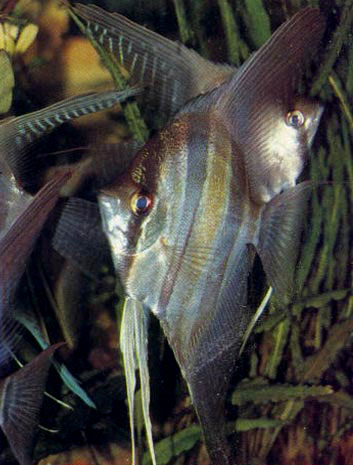
Pterophyllum Altum
|
| Pterophyllum Altum |
Right: View of an altum-type angel.
The next morning Karl called me excitedly..."See, I was right.
They did spawn...just like they have many times before."
"Karli," I said, "come over here immediately and get me...No,
never mind, I'll take a taxi." In 30 minutes I was in his office
taking photos of the spawning pair. One was an eimekei-type and
one was an altum, it seemed, but without the corpse of the
breeders I would be unable to tell with certainty. "What will
you do with the eggs?" I asked Karli?
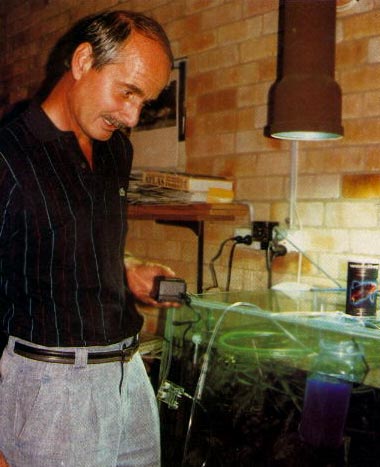
Karl Schnell adjusting the air pump, which is aimed to play a stream of bubbles
immediately in front of the eggs. He only feeds Wardley fish food in
flake form to his community aquarium fishes. The breeding angelfish have
never seen live foods! "Nothing," he answered.
|
| Karl
Schnell adjusting the air pump. |
"I don't have staff, this is vacation time, and I'm too busy
with my new house. Besides, my fish house isn't finished yet."
"!*&$ (and other unmentionabes). Karli, you may have made
aquarium history. Let's save the spawn!"
"How?" asked Karli.
"OK let me show you."
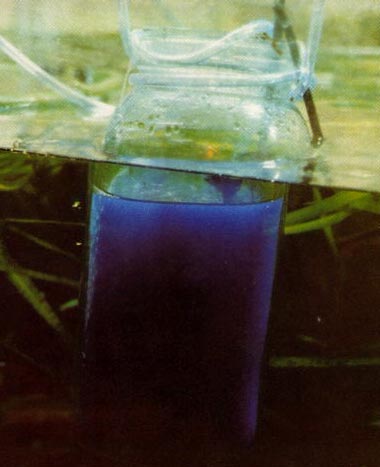
Pterophyllum Altum
|
| Pterophyllum Altum |
I took the bottom jar from a Diatom Filter and filled it almost
full of water from the same aquarium. I added enough Wardley's
Promethyasul, until the water was a deep blue. Then I carefully
pinched off the bottom of leaf upon which the eggs had been
deposited and put it into the jar. Right: The jar with the eggs
floats in Karli's aquarium. The long stem of the leaf was folded
onto the outside edge of the jar and held in position with a
rubber band, squeezing it against the neck of the jar. A small
vibrator pump and airstone were connected up and a steady stream
of bubbles were allowed to play on the leaf. The jar was then
hung in the aquarium with the neck an inch above the surface.
This maintained a proper temperature in the small container (81°
F). It only took three day for the eggs to hatch and the young
to fall off the leaf and lay huddled on the floor of the jar.
"Karli," I said. "Do you know what to do now?"
"Yes, Doctor. I just add some egg infusion, or infusoria, as
soon as they are free-swimming. I follow this in a few days with
newly hatched brine shrimp and stand back as they grow."
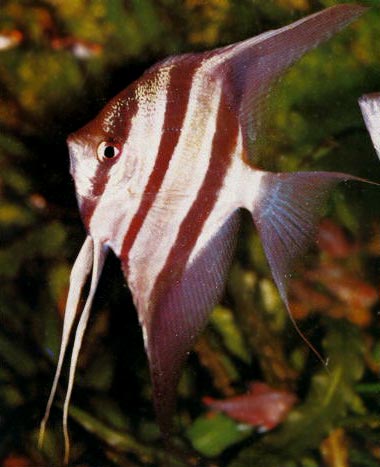
Pterophyllum Altum
|
| Pterophyllum Altum |
Right: Another of Karli's lovely altum type angels.
"Good, Karli. Start the cultures of brine shrimp and infusoria
now."
"I can't. Remember, the office is closed. I only came here to be
polite to you. There is no one to care for them."
"Karli, !?*$& you, who is the best angelfish breeder in the
area?"
"He told me and we called him. He came down the next day and
took the jar with the newly hatched fish bouncing on the bottom.
This was all done while I was winging my way to Auckland.
A few days later I called Karli.
"Yes, Mr. So-and-so came and took the fish. But the man changed
the water and all the fry died immediately."
I couldn't talk.
I hung up the phone and sat on the edge of the bed. Would Karli
be able to spawn them again? Would he be able to save the babies
and raise them? 
|